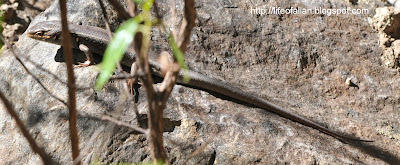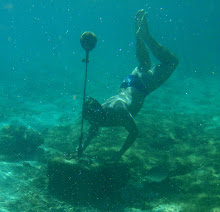
The
Grand High Tops Walk is one of the best walks I have done in Australia! It is mentioned in my good old "Walking in Australia - 60 Great Walks" book. The beauty of the Warrumbungle National Park is that it has it all, including some spectacular vistas. Alfred J. Pincham donated some very pretty country side - probably not the worlds best farmland, but pretty indeed.

Once again I will have to excuse the ridiculously large delay between when I actually experienced the events described in my blog post and when I managed to get it online. Our Warrumbungle trip was from before the terrible fires that
ravaged Warrumbungle National park earlier in the
year. Hopefully, the flora and fauna in the park will once again show its resilience towards fires and manage to spring back to glory much faster than what anyone expect.


Great views and the iconic rock formation known as "The Breadknife" located approximately a third of the way into the walk, easily justify the uphill struggle you have to endure during the first part of the walk. The "razor" thin vertical rock formation is pretty special indeed.



Having been amazed by standing at the base of the breadknife itself, it only gets better when continuing the walk. As you wind your way up the mountain, you get increasingly impressive views, of the breadknife in particular.


Halfway through the tour it is mandatory to sit for a while "on top of the world" and just be amazed by the spectacular volcanic landscapes surrounding you. Ancient old volcanic "cores" have been left standing while the landscape around them have eroded away. Creating a varied rough green landscape with huge bare brown-black domes scattered around breaking all the greenness. Fantastic views - That day, sitting there in Warrumbungle looking at all that prettiness, was the day I decided to invest in a wider lens, 50 mm did just not cut it! - I know, I can stitch photos together, but there is something special in being able to catch it all in one go.


There was good wildlife along the way. In the forest part in the beginning of the walk was a good selection of birds, nothing breathtakingly exciting, but nice to have some winged companions around during the walk.



Warrumbungle National Park is a well visited park and the walking tracks are constantly busy, hence birds are very familiar with us humans roaming around in their habitat. This allowed me to get fairly close to a number of birds and get some decent close-ups. Like for the Double-barred Finch and Red-Browed Finch below:


In the rockier upper part of the walk we very treated with numerous sightings of
White's Skink,
Egernia Whitii. Wikipedia mention that "It is highly variable", which the three photos below will support, note that color is by all means a poor identification method for this skink, but the spots is the give away.



Also a Copper-tailed Skink,
Ctenotus taeniolatus, was out to enjoy the heat and despite of not seeing any new birds and the sad lack of a snake sighting, we could have hoped for no more.


All in all a fantastic road trip with my Danish visitors! Gundabooka National Park and Warrumbungle National Park is a great combination for a display of some Australian nature. One being dry, red and dusty and the other sporting green forest, old brown volcanoes and fantastic walks - as mentioned above Warrumbungle burned earlier in the year, but I am sure it will soon be worth visiting again.
 Those WA trips always ends up being fairly action packed, with a good variety of things to do. I keep treasuring the chance of having a walk in John Forrest National Park. It is just a genuine, good, honest WA national park wedged in between a highway and ever expanding real estate - no super exotic wildlife or stunning waterfall - just dry lovely scented Australian scrub and the possibility of seeing a little wildlife.
Those WA trips always ends up being fairly action packed, with a good variety of things to do. I keep treasuring the chance of having a walk in John Forrest National Park. It is just a genuine, good, honest WA national park wedged in between a highway and ever expanding real estate - no super exotic wildlife or stunning waterfall - just dry lovely scented Australian scrub and the possibility of seeing a little wildlife.

 Happy about the photo above! The shutter speed was quick enough to get the eye of the Brown Honeyeater good and sharp and making the bird stand still in the air, and slow enough to allow movement of the wings and make it all look alive - Pure luck! :-)
I have read quite a few blog and forum posts on how to perfect this type of shooting. For birders it seems particular well developed/described for the purpose of taking in flight stills of Hummingbirds, which due to the higher frequency of their wing beat increase the challenge.
Happy about the photo above! The shutter speed was quick enough to get the eye of the Brown Honeyeater good and sharp and making the bird stand still in the air, and slow enough to allow movement of the wings and make it all look alive - Pure luck! :-)
I have read quite a few blog and forum posts on how to perfect this type of shooting. For birders it seems particular well developed/described for the purpose of taking in flight stills of Hummingbirds, which due to the higher frequency of their wing beat increase the challenge.

 Above I wrote "no super exotic wildlife", however, the level of exotic depends, as always, on what you are used to and for a kid as I living in Sydney (at the time) something like a Red-capped parrot will trigger some celebration and a few clicks on the camera. Red-capped Parrot is not a rare bird at all, as long as you are in the south west corner of WA, elsewhere it is super rare! For some reason this bird had eluded me on all my previous visits to WA - at least, I had never been sure enough to actually claim to have seen it - this time around we saw two, male and female, both of the photos above are of the male.
Above I wrote "no super exotic wildlife", however, the level of exotic depends, as always, on what you are used to and for a kid as I living in Sydney (at the time) something like a Red-capped parrot will trigger some celebration and a few clicks on the camera. Red-capped Parrot is not a rare bird at all, as long as you are in the south west corner of WA, elsewhere it is super rare! For some reason this bird had eluded me on all my previous visits to WA - at least, I had never been sure enough to actually claim to have seen it - this time around we saw two, male and female, both of the photos above are of the male.



 Otherwise Perth was delivering all the usual stuff. Black swans on the river, a pod of dolphins playing around in the waters of Matilda Bay and an excellent variety of blooming bottlebrushes, Callistemon, in Kings park. All very common daily happenings for those Perthians.
Otherwise Perth was delivering all the usual stuff. Black swans on the river, a pod of dolphins playing around in the waters of Matilda Bay and an excellent variety of blooming bottlebrushes, Callistemon, in Kings park. All very common daily happenings for those Perthians.






















































